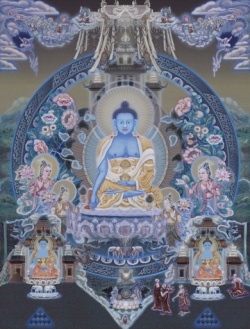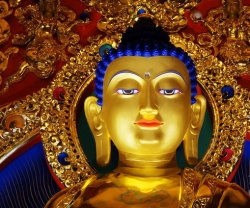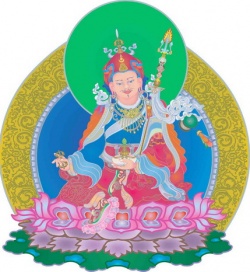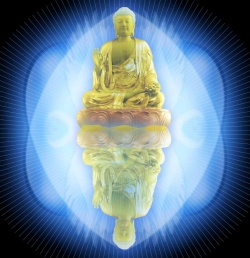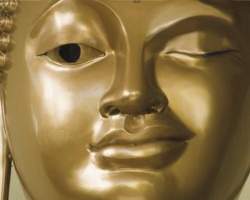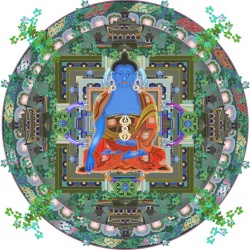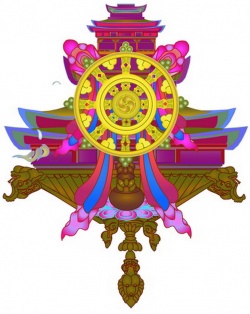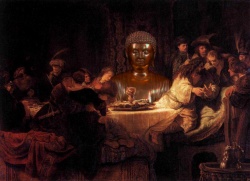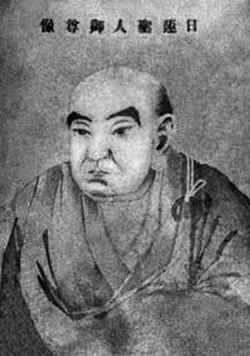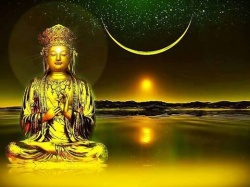Difference between revisions of "Basic Ideas of Yogacara Buddhism"
| Line 1: | Line 1: | ||
{{DisplayImages|1634|1955|1009|4427|3021|2765|1629|4495|3718|2520|3157|1019|512|1697|1397|3814|2060|2768|3661|2456|765|1435|3391|3155|674}} | {{DisplayImages|1634|1955|1009|4427|3021|2765|1629|4495|3718|2520|3157|1019|512|1697|1397|3814|2060|2768|3661|2456|765|1435|3391|3155|674}} | ||
| − | + | ||
[[by Roger Zim]] | [[by Roger Zim]] | ||
| Line 14: | Line 14: | ||
Its {{Wiki|purpose}} is to give a general {{Wiki|schema}} and overview of [[Yogacara]] with a minimum of [[doctrinal]] analysis. Therefore, details of [[Yogacara]] history and the context of its [[development]] have not been included. [[Sanskrit]] terms also have been avoided, except where there is no {{Wiki|equivalent}} term in English. The paper is divided into numbered [[sections]] which describe the components of [[Yogacara]] {{Wiki|theory}}. Since the components of [[Yogacara]] are like blocks that together make a unified {{Wiki|structure}}, their order within the paper is arbitrary (ideally you should read all the [[sections]] simultaneously). The components are presented beginning with the [[simplicity]] of [[enlightenment]] through the increasing complexity of the process of [[consciousness]]. Terms, or components, not previously explained or defined are followed by a number in brackets [ ] that indicates a section with more [[information]]. | Its {{Wiki|purpose}} is to give a general {{Wiki|schema}} and overview of [[Yogacara]] with a minimum of [[doctrinal]] analysis. Therefore, details of [[Yogacara]] history and the context of its [[development]] have not been included. [[Sanskrit]] terms also have been avoided, except where there is no {{Wiki|equivalent}} term in English. The paper is divided into numbered [[sections]] which describe the components of [[Yogacara]] {{Wiki|theory}}. Since the components of [[Yogacara]] are like blocks that together make a unified {{Wiki|structure}}, their order within the paper is arbitrary (ideally you should read all the [[sections]] simultaneously). The components are presented beginning with the [[simplicity]] of [[enlightenment]] through the increasing complexity of the process of [[consciousness]]. Terms, or components, not previously explained or defined are followed by a number in brackets [ ] that indicates a section with more [[information]]. | ||
| − | |||
| − | 2/ [[ENLIGHTENED WISDOM]] Although the [[enlightened mind]] is one, it is useful to classify its [[activities]] into four types of [[enlightened wisdom]] which are the functions of the [[Buddhic mind]]. These reflect the [[transformation]] of the [[eight consciousnesses]] [8] into [[fundamental wisdom]] | + | 1/ ===THE [[MIND OF ENLIGHTENMENT]]=== |
| + | |||
| + | |||
| + | The {{Wiki|purpose}} and goal of [[human]] [[life]] is to reach [[enlightenment]]. [[Yogacara]] considers [[enlightenment]] a [[state]] of [[True Suchness]], or [[Thusness]], meaning that it is the [[ultimate nature]] of all things. In [[reality]] [[enlightenment]] is the only truly [[existent]] [[state]]. In the [[perfect clarity]] of [[enlightenment]] there is total [[awareness]] and complete [[understanding]]. There is no {{Wiki|discrimination}} between inside and outside, or internal and external. In [[enlightenment]] there is only the singular total [[truth]] of {{Wiki|unity}}, which subsumes the "I" of the ego-differentiated [[self]]. After [[enlightenment]] the [[mind's]] process of seeking outside itself ceases, as does the process of sending [[energy]] out (in the [[form]] of [[attachments]] to the external [[conditional]] [[world]]). Rather, the [[mind]] is now {{Wiki|contemplative}} absorbing [[energy]] for the [[benefit]] of itself and [[humanity]], like a [[flower]] absorbing the [[rays of the sun]]. | ||
| + | |||
| + | 2/ ===[[ENLIGHTENED WISDOM]]=== | ||
| + | |||
| + | Although the [[enlightened mind]] is one, it is useful to classify its [[activities]] into four types of [[enlightened wisdom]] which are the functions of the [[Buddhic mind]]. These reflect the [[transformation]] of the [[eight consciousnesses]] [8] into [[fundamental wisdom]] | ||
[3] : | [3] : | ||
| Line 28: | Line 34: | ||
4) The [[eighth consciousness]] becomes the Great [[Mirror wisdom]]. This [[wisdom]] reflects the entire [[universe]] without [[distortion]]. Although the four [[wisdoms]] do not [[manifest]] completely until [[enlightenment]], aspects of Wonderful Contemplation and [[Great Mirror wisdom]] begin to [[function]] in a lesser {{Wiki|degree}} before [[enlightenment]]. | 4) The [[eighth consciousness]] becomes the Great [[Mirror wisdom]]. This [[wisdom]] reflects the entire [[universe]] without [[distortion]]. Although the four [[wisdoms]] do not [[manifest]] completely until [[enlightenment]], aspects of Wonderful Contemplation and [[Great Mirror wisdom]] begin to [[function]] in a lesser {{Wiki|degree}} before [[enlightenment]]. | ||
| − | 3/ [[THREE BUDDHIC BODIES]] | + | |
| + | |||
| + | 3/ ===[[THREE BUDDHIC BODIES]]=== | ||
| + | |||
| + | |||
The [[Buddha]] is said to have [[three bodies]]. Only the third, the [[Dharma body]], is {{Wiki|real}}. The [[Transformation]] and [[Enjoyment]] [[bodies]] are [[emanations]] of the [[Dharma body]], and are [[relative]] expedient [[bodies]] corresponding to unenlightened [[consciousness]]. | The [[Buddha]] is said to have [[three bodies]]. Only the third, the [[Dharma body]], is {{Wiki|real}}. The [[Transformation]] and [[Enjoyment]] [[bodies]] are [[emanations]] of the [[Dharma body]], and are [[relative]] expedient [[bodies]] corresponding to unenlightened [[consciousness]]. | ||
| Line 42: | Line 52: | ||
b) The [[self-existent]] [[body]] representing the [[ultimate nature of reality]], [[thusness]] and [[emptiness]]. It is the [[transformed]] [[storehouse-consciousness]] [8] and is the [[body]] that is [[realized]] on [[attaining]] [[enlightenment]]. This [[body]] is equated with [[Great Mirror wisdom]]. | b) The [[self-existent]] [[body]] representing the [[ultimate nature of reality]], [[thusness]] and [[emptiness]]. It is the [[transformed]] [[storehouse-consciousness]] [8] and is the [[body]] that is [[realized]] on [[attaining]] [[enlightenment]]. This [[body]] is equated with [[Great Mirror wisdom]]. | ||
| − | 4/ | + | |
| + | |||
| + | 4/ ===[[THREE WISDOMS]]=== | ||
| + | |||
| + | |||
1) Before [[enlightenment]] there is only applied [[wisdom]] which is discursive and is used in the everyday [[world]]. Once this [[knowledge]] is focused towards [[enlightenment]], it becomes a preparation for acquiring [[fundamental wisdom]]. In the [[state of enlightenment]] there is only [[pure wisdom]] which has two aspects; [[fundamental wisdom]] and [[subsequently-attained wisdom]]. | 1) Before [[enlightenment]] there is only applied [[wisdom]] which is discursive and is used in the everyday [[world]]. Once this [[knowledge]] is focused towards [[enlightenment]], it becomes a preparation for acquiring [[fundamental wisdom]]. In the [[state of enlightenment]] there is only [[pure wisdom]] which has two aspects; [[fundamental wisdom]] and [[subsequently-attained wisdom]]. | ||
| Line 50: | Line 64: | ||
3) [[Subsequently-attained wisdom]] is a [[pure form of knowledge]] that flows out of non-distinction making, so it is "[[purified mundane knowledge]]." This is an expedient [[wisdom]] that can analyze [[dharmas]] without becoming [[attached]], so it can "eliminate {{Wiki|confusion}} about [[phenomena]]..." Although this [[discriminative knowledge]] is at a lower level than [[fundamental wisdom]], it is used by the [[Buddha]] for the {{Wiki|purpose}} of [[benefiting others]]; all the [[Buddha's teaching]] is [[attained]] [[wisdom]]. This kind of [[wisdom]] explains how, in [[enlightenment]], a [[person]] can still deal with [[relative]] [[appearances]] in the everyday [[world]]. | 3) [[Subsequently-attained wisdom]] is a [[pure form of knowledge]] that flows out of non-distinction making, so it is "[[purified mundane knowledge]]." This is an expedient [[wisdom]] that can analyze [[dharmas]] without becoming [[attached]], so it can "eliminate {{Wiki|confusion}} about [[phenomena]]..." Although this [[discriminative knowledge]] is at a lower level than [[fundamental wisdom]], it is used by the [[Buddha]] for the {{Wiki|purpose}} of [[benefiting others]]; all the [[Buddha's teaching]] is [[attained]] [[wisdom]]. This kind of [[wisdom]] explains how, in [[enlightenment]], a [[person]] can still deal with [[relative]] [[appearances]] in the everyday [[world]]. | ||
| − | 5/ [[CONSCIOUSNESS]] | + | |
| + | 5/ ===[[CONSCIOUSNESS]]=== | ||
| + | |||
[[Consciousness]] is [[awareness]] of a "[[self]]". The fundamental [[doctrine]] of the [[Yogacara]] school is "that all [[phenomenal existence]] is [[fabricated]] by [[consciousness]]." [[Consciousness]] is the [[basis of all]] [[activities]] from [[birth]] to [[attaining]] [[enlightenment]]; "...all is based upon the coming into being and the ceasing to be of [[consciousness]], i.e., of {{Wiki|distinctions}} in the [[mind]]." [[Consciousness]] is the {{Wiki|distinction}} making [[activity]] of the [[mind]], both in making and having {{Wiki|distinctions}}, including the states we consider the [[conscious]] as well as the [[unconscious]]. [[Consciousness]], in making {{Wiki|distinctions}} between [[self]] and other, becomes the [[subject]] which treats everything else as [[object]]. [[Consciousness]] itself is {{Wiki|real}}. It [[exists]] as a series, or {{Wiki|stream}}, of successive momentary [[awareness]] of events, each immediately replaced by [[consciousness]] in the next [[moment]]. [[Consciousness]] "has no substantiality ...and is dependent on the [[consciousness]] of the preceding instant." | [[Consciousness]] is [[awareness]] of a "[[self]]". The fundamental [[doctrine]] of the [[Yogacara]] school is "that all [[phenomenal existence]] is [[fabricated]] by [[consciousness]]." [[Consciousness]] is the [[basis of all]] [[activities]] from [[birth]] to [[attaining]] [[enlightenment]]; "...all is based upon the coming into being and the ceasing to be of [[consciousness]], i.e., of {{Wiki|distinctions}} in the [[mind]]." [[Consciousness]] is the {{Wiki|distinction}} making [[activity]] of the [[mind]], both in making and having {{Wiki|distinctions}}, including the states we consider the [[conscious]] as well as the [[unconscious]]. [[Consciousness]], in making {{Wiki|distinctions}} between [[self]] and other, becomes the [[subject]] which treats everything else as [[object]]. [[Consciousness]] itself is {{Wiki|real}}. It [[exists]] as a series, or {{Wiki|stream}}, of successive momentary [[awareness]] of events, each immediately replaced by [[consciousness]] in the next [[moment]]. [[Consciousness]] "has no substantiality ...and is dependent on the [[consciousness]] of the preceding instant." | ||
| Line 58: | Line 74: | ||
There is [[nothing]] separate or {{Wiki|independent}} from [[consciousness]]. The [[world]] is our {{Wiki|perceptual}} construct and an analysis of the unenlightened [[mind]] will show different levels of [[perception]] which are based in a [[storehouse consciousness]] [8] containing the [[karmic seeds]] [6] of former [[actions]]. | There is [[nothing]] separate or {{Wiki|independent}} from [[consciousness]]. The [[world]] is our {{Wiki|perceptual}} construct and an analysis of the unenlightened [[mind]] will show different levels of [[perception]] which are based in a [[storehouse consciousness]] [8] containing the [[karmic seeds]] [6] of former [[actions]]. | ||
| − | 6/ [[KARMA]] | + | |
| + | 6/ ===[[KARMA]]=== | ||
| + | |||
The result of our intentional [[actions]] is [[karma]]. The {{Wiki|consequences}} of these [[actions]] remain as traces or [[seeds]] planted in the [[storehouse consciousness]]. These [[seeds]] germinate over [[time]] and generate more [[seeds]]. Therefore, our [[lives]], are driven by {{Wiki|past}} [[actions]] which compel us to decisions about {{Wiki|future}} [[actions]]. The [[theory of karma]] accounts for the "continuity of [[personality]] through [[death]], or {{Wiki|unconsciousness}}..." Once a seed produces its fruit, it is used up. However, new [[seeds]] come to [[fruition]] in each [[moment]]. Until the [[time]] of [[enlightenment]], while we continue to believe in the [[reality]] of our {{Wiki|perceptual}} framework, this process "...creates [[seeds]] that will ripen into further [[delusion]]." | The result of our intentional [[actions]] is [[karma]]. The {{Wiki|consequences}} of these [[actions]] remain as traces or [[seeds]] planted in the [[storehouse consciousness]]. These [[seeds]] germinate over [[time]] and generate more [[seeds]]. Therefore, our [[lives]], are driven by {{Wiki|past}} [[actions]] which compel us to decisions about {{Wiki|future}} [[actions]]. The [[theory of karma]] accounts for the "continuity of [[personality]] through [[death]], or {{Wiki|unconsciousness}}..." Once a seed produces its fruit, it is used up. However, new [[seeds]] come to [[fruition]] in each [[moment]]. Until the [[time]] of [[enlightenment]], while we continue to believe in the [[reality]] of our {{Wiki|perceptual}} framework, this process "...creates [[seeds]] that will ripen into further [[delusion]]." | ||
| Line 66: | Line 84: | ||
The [[karmic]] process has three stages: 1) Giving rise to [[delusion]] has one [[root]] in the [[sixth consciousness]] [10], whose [[actions]] lead to [[activity]] and therefore [[karma]]. 2) Creating [[karma]] involves planting [[seeds]] in the [[eighth consciousness]] [8]. The ongoing cycle of [[life]], [[death]], and [[rebirth]] draws the [[eighth consciousness]] back into the six levels of [[existence]] [15]. 3) Finally, undergoing retribution is the germination of [[karmic seeds]]; we reap what we have sown. | The [[karmic]] process has three stages: 1) Giving rise to [[delusion]] has one [[root]] in the [[sixth consciousness]] [10], whose [[actions]] lead to [[activity]] and therefore [[karma]]. 2) Creating [[karma]] involves planting [[seeds]] in the [[eighth consciousness]] [8]. The ongoing cycle of [[life]], [[death]], and [[rebirth]] draws the [[eighth consciousness]] back into the six levels of [[existence]] [15]. 3) Finally, undergoing retribution is the germination of [[karmic seeds]]; we reap what we have sown. | ||
| − | 7/ [[DHARMAS]] | + | |
| + | |||
| + | 7/ ===[[DHARMAS]]=== | ||
| + | |||
| + | |||
"[[Dharmas]] are the [[Wikipedia:Absolute (philosophy)|ultimate]] factors that support '[[existence]]'...." They are basic [[interdependent]] patterns within the overall [[nature]] of [[reality]]. Each [[dharma]] is a mental-construct with a specific process that consists of a {{Wiki|stream}} of momentary events. [[Dharmas]] are [[attachments]] to an [[illusory]] [[reality]]. In terms of process and events [[dharmas]] interact with all [[eight consciousnesses]]. | "[[Dharmas]] are the [[Wikipedia:Absolute (philosophy)|ultimate]] factors that support '[[existence]]'...." They are basic [[interdependent]] patterns within the overall [[nature]] of [[reality]]. Each [[dharma]] is a mental-construct with a specific process that consists of a {{Wiki|stream}} of momentary events. [[Dharmas]] are [[attachments]] to an [[illusory]] [[reality]]. In terms of process and events [[dharmas]] interact with all [[eight consciousnesses]]. | ||
| Line 72: | Line 94: | ||
[[Yogacara]] posits one hundred [[dharmas]], which can be categorized according to the [[three natures]] [14], since [[dharmas]] lack any {{Wiki|real}} self-existence. There are five categories of [[dharmas]] (in descending order): First; the eight [[mind]] [[dharmas]] are supreme and [[manifest]] as the [[eight consciousnesses]]. Second; the fifty-one [[dharmas]] interactive with the [[mind]] supplement the [[mind]] [[dharmas]] and are subdivided into six categories: | [[Yogacara]] posits one hundred [[dharmas]], which can be categorized according to the [[three natures]] [14], since [[dharmas]] lack any {{Wiki|real}} self-existence. There are five categories of [[dharmas]] (in descending order): First; the eight [[mind]] [[dharmas]] are supreme and [[manifest]] as the [[eight consciousnesses]]. Second; the fifty-one [[dharmas]] interactive with the [[mind]] supplement the [[mind]] [[dharmas]] and are subdivided into six categories: | ||
| + | |||
| + | <poem> | ||
1) five universally interactive ([[attention]], [[conceptualization]], etc.), | 1) five universally interactive ([[attention]], [[conceptualization]], etc.), | ||
2) [[five particular states]] ([[desire]], [[concentration]], etc.), | 2) [[five particular states]] ([[desire]], [[concentration]], etc.), | ||
| Line 78: | Line 102: | ||
5) twenty derivative [[afflictions]] ([[deceit]], [[jealousy]], {{Wiki|torpor}}, [[lack of shame]], etc.), and | 5) twenty derivative [[afflictions]] ([[deceit]], [[jealousy]], {{Wiki|torpor}}, [[lack of shame]], etc.), and | ||
6) four unfixed ([[sleep]], [[regret]], etc.). | 6) four unfixed ([[sleep]], [[regret]], etc.). | ||
| + | </poem> | ||
| + | |||
The [[afflictions]] and [[wholesome]] [[dharmas]] represent further categorizations of {{Wiki|distinctions}} in the [[sixth consciousness]]. | The [[afflictions]] and [[wholesome]] [[dharmas]] represent further categorizations of {{Wiki|distinctions}} in the [[sixth consciousness]]. | ||
| Line 86: | Line 112: | ||
The [[realization]] that all [[dharmas]] are [[nothing]] but mental-constructs is an [[essential]] step on the [[path]] to [[enlightenment]]. In that final [[state]] the [[wisdom]] of Wonderful Contemplation "[[understands]] without [[distortion]] the {{Wiki|individual}} and [[universal]] [[dharmas]]...." | The [[realization]] that all [[dharmas]] are [[nothing]] but mental-constructs is an [[essential]] step on the [[path]] to [[enlightenment]]. In that final [[state]] the [[wisdom]] of Wonderful Contemplation "[[understands]] without [[distortion]] the {{Wiki|individual}} and [[universal]] [[dharmas]]...." | ||
| − | 8/ [[EIGHTH CONSCIOUSNESS]] | + | |
| + | |||
| + | 8/ ===[[EIGHTH CONSCIOUSNESS]]=== | ||
| + | |||
| + | |||
In [[Yogacara]] {{Wiki|theory}} everything is "[[mind only]]" and this [[consciousness]] is divided into eight [[sections]]. The [[principal]] part of [[consciousness]] is the [[alaya]] or "[[storehouse consciousness]]" which is the basis of the seven other [[consciousnesses]]. All eight comprise the [[mind]] [[dharmas]] and the fifty [[dharmas]] that interact with the [[mind]]. | In [[Yogacara]] {{Wiki|theory}} everything is "[[mind only]]" and this [[consciousness]] is divided into eight [[sections]]. The [[principal]] part of [[consciousness]] is the [[alaya]] or "[[storehouse consciousness]]" which is the basis of the seven other [[consciousnesses]]. All eight comprise the [[mind]] [[dharmas]] and the fifty [[dharmas]] that interact with the [[mind]]. | ||
| Line 100: | Line 130: | ||
The [[alaya]] has two divisions; the perceiving (the [[subject]]) and the [[perceived]] (the [[object]]). The former is linked to the [[seventh consciousness]] [9], while the [[latter]] is linked to the [[sixth consciousness]] [10] and the five {{Wiki|perceptual}} [[consciousnesses]] [13]. When the [[perceived]] [[division]] is [[transformed]] during [[enlightenment]] it becomes subsequently-attained [[wisdom]] [3]. | The [[alaya]] has two divisions; the perceiving (the [[subject]]) and the [[perceived]] (the [[object]]). The former is linked to the [[seventh consciousness]] [9], while the [[latter]] is linked to the [[sixth consciousness]] [10] and the five {{Wiki|perceptual}} [[consciousnesses]] [13]. When the [[perceived]] [[division]] is [[transformed]] during [[enlightenment]] it becomes subsequently-attained [[wisdom]] [3]. | ||
| − | 9/ [[SEVENTH CONSCIOUSNESS]] | + | |
| + | |||
| + | 9/ ===[[SEVENTH CONSCIOUSNESS]]=== | ||
| + | |||
| + | |||
The [[seventh consciousness]] obscures a person's [[true nature]] with the [[ego]] {{Wiki|concept}} of "I". It is also known as the "defiling/transmitter [[consciousness]]" because it is the home of the [[illusory]] "...[[ego]] [[individuality]] with which it defiles the first [[six consciousnesses]]..." by {{Wiki|obscuring}} them with its [[Wikipedia:concept|concepts]] of [[self]]. The [[seventh consciousness]] also defiles the [[eighth consciousness]] by attributing to it {{Wiki|characteristics}} of a {{Wiki|real}} "[[self]]" that [[exists]] in {{Wiki|space and time}}. | The [[seventh consciousness]] obscures a person's [[true nature]] with the [[ego]] {{Wiki|concept}} of "I". It is also known as the "defiling/transmitter [[consciousness]]" because it is the home of the [[illusory]] "...[[ego]] [[individuality]] with which it defiles the first [[six consciousnesses]]..." by {{Wiki|obscuring}} them with its [[Wikipedia:concept|concepts]] of [[self]]. The [[seventh consciousness]] also defiles the [[eighth consciousness]] by attributing to it {{Wiki|characteristics}} of a {{Wiki|real}} "[[self]]" that [[exists]] in {{Wiki|space and time}}. | ||
| Line 110: | Line 144: | ||
It also supports the eight major-grade derivative [[afflictions]] ([[laziness]], {{Wiki|distraction}}, lack of [[faith]], etc.). 10/ | It also supports the eight major-grade derivative [[afflictions]] ([[laziness]], {{Wiki|distraction}}, lack of [[faith]], etc.). 10/ | ||
| − | [[SIXTH CONSCIOUSNESS]] | + | |
| + | |||
| + | ===[[SIXTH CONSCIOUSNESS]]=== | ||
| + | |||
| + | |||
[[Cognition]] and [[perception]] take place in the [[sixth consciousness]]. The sixth, along with the five [[perceptual consciousnesses]] [13], [[perceives]] [[worldly phenomena]]. The sixth takes "[[manifestations]] of the [[five aggregates]] (the five "heaps" of [[dharmas]]) as [[object]]...[and] generates various non-continuous [[Wikipedia:concept|concepts]] of [[self]]." This process also includes its interaction with the fifty-one [[dharmas]] interactive with the [[mind]]. | [[Cognition]] and [[perception]] take place in the [[sixth consciousness]]. The sixth, along with the five [[perceptual consciousnesses]] [13], [[perceives]] [[worldly phenomena]]. The sixth takes "[[manifestations]] of the [[five aggregates]] (the five "heaps" of [[dharmas]]) as [[object]]...[and] generates various non-continuous [[Wikipedia:concept|concepts]] of [[self]]." This process also includes its interaction with the fifty-one [[dharmas]] interactive with the [[mind]]. | ||
| Line 119: | Line 157: | ||
| − | 11/ [[THREE MODES OF KNOWLEDGE]] | + | |
| + | |||
| + | 11/ ===[[THREE MODES OF KNOWLEDGE]]=== | ||
| + | |||
| + | |||
Distinction making, which is used by the [[sixth consciousness]], involves [[subject]] and [[object]]. The [[subject]] has [[three types of knowledge]]: | Distinction making, which is used by the [[sixth consciousness]], involves [[subject]] and [[object]]. The [[subject]] has [[three types of knowledge]]: | ||
| Line 130: | Line 172: | ||
| − | 12/ [[THREE KINDS OF STATES]] | + | |
| + | |||
| + | 12/ ===[[THREE KINDS OF STATES]]=== | ||
| + | |||
| + | |||
The second part of {{Wiki|distinction}} making, refers to the [[objects]] of [[perception]]: | The second part of {{Wiki|distinction}} making, refers to the [[objects]] of [[perception]]: | ||
| Line 140: | Line 186: | ||
3) [[State]] of transposed [[substance]] are the [[distortions]] of false [[thinking]] generated by the {{Wiki|concept}} of "[[self]]": The {{Wiki|dog}} likes my good vibes. | 3) [[State]] of transposed [[substance]] are the [[distortions]] of false [[thinking]] generated by the {{Wiki|concept}} of "[[self]]": The {{Wiki|dog}} likes my good vibes. | ||
| − | |||
| − | The fifth through first [[consciousnesses]] are the {{Wiki|perceptual}} [[consciousnesses]]. They comprise the [[visual]], {{Wiki|auditory}}, {{Wiki|olfactory}}, {{Wiki|gustatory}}, and {{Wiki|tactile}} [[senses]]. These [[senses]] arise from the [[perceived]] [[division]] of the [[eighth consciousness]]. Each {{Wiki|organ}} of [[perception]] has two parts: 1) its [[physical]] [[substance]] ([[eyes]], {{Wiki|ears}}, {{Wiki|nose}}, {{Wiki|tongue}}, or [[body]]) and the {{Wiki|nerves}} connecting it to the [[perceived]] [[division]] and 2) its [[mental]] component. They can appear in any order or all at once, depending on the situation; for instance, an {{Wiki|illness}} or [[shock]] can stop their operation. The five [[perceptual consciousnesses]] interact with the thirty-one [[dharmas]] interactive with the [[mind]] and work in {{Wiki|conjunction}} with the [[sixth consciousness]] which {{Wiki|processes}} their input [[to construct]] a [[mental]] picture of [[reality]]. After [[perceptions]] from the first [[five consciousnesses]] are assimilated in the [[sixth consciousness]], they are introduced into the [[seventh consciousness]], which puts these [[cognitions]] into the eighth as though the [[latter]] were a {{Wiki|real}} "[[self]]". This continual process [[plants]] more [[karmic seeds]] in the [[eighth consciousness]]. | + | |
| + | 13/ ===[[PERCEPTUAL CONSCIOUSNESSES]]=== | ||
| + | |||
| + | |||
| + | |||
| + | The fifth through first [[consciousnesses]] are the {{Wiki|perceptual}} [[consciousnesses]]. They comprise the [[visual]], {{Wiki|auditory}}, {{Wiki|olfactory}}, {{Wiki|gustatory}}, and {{Wiki|tactile}} [[senses]]. These [[senses]] arise from the [[perceived]] [[division]] of the [[eighth consciousness]]. Each {{Wiki|organ}} of [[perception]] has two parts: 1) its [[physical]] [[substance]] ([[eyes]], {{Wiki|ears}}, {{Wiki|nose}}, {{Wiki|tongue}}, or [[body]]) and the {{Wiki|nerves}} connecting it to the [[perceived]] [[division]] and 2) its [[mental]] component. They can appear in any order or all at once, depending on the situation; for instance, an {{Wiki|illness}} or [[shock]] can stop their operation. | ||
| + | |||
| + | The five [[perceptual consciousnesses]] interact with the thirty-one [[dharmas]] interactive with the [[mind]] and work in {{Wiki|conjunction}} with the [[sixth consciousness]] which {{Wiki|processes}} their input [[to construct]] a [[mental]] picture of [[reality]]. After [[perceptions]] from the first [[five consciousnesses]] are assimilated in the [[sixth consciousness]], they are introduced into the [[seventh consciousness]], which puts these [[cognitions]] into the eighth as though the [[latter]] were a {{Wiki|real}} "[[self]]". This continual process [[plants]] more [[karmic seeds]] in the [[eighth consciousness]]. | ||
| + | |||
None of the five [[perceptual consciousnesses]] contain the potential for making [[moral]] {{Wiki|distinctions}}, so they are of {{Wiki|indeterminate}} [[nature]] [19]. All five [[function]] on the first of the [[nine grounds]], while [[eyes]], {{Wiki|ears}}, and [[body]] also occupy the [[second ground]]. None of them arise after the [[second ground]] - the [[first dyhana]] [17]. The five {{Wiki|perceptual}} [[consciousness]] are: | None of the five [[perceptual consciousnesses]] contain the potential for making [[moral]] {{Wiki|distinctions}}, so they are of {{Wiki|indeterminate}} [[nature]] [19]. All five [[function]] on the first of the [[nine grounds]], while [[eyes]], {{Wiki|ears}}, and [[body]] also occupy the [[second ground]]. None of them arise after the [[second ground]] - the [[first dyhana]] [17]. The five {{Wiki|perceptual}} [[consciousness]] are: | ||
| Line 156: | Line 209: | ||
[[First consciousness]]: [[Eye consciousness]] or [[seeing]] [[perceives]] at a distance. | [[First consciousness]]: [[Eye consciousness]] or [[seeing]] [[perceives]] at a distance. | ||
| − | 14/ [[THREE NATURES]] | + | |
| + | |||
| + | 14/ ===[[THREE NATURES]]=== | ||
| + | |||
| + | |||
The {{Wiki|theory}} of the [[three natures]] is one of the central [[Wikipedia:concept|concepts]] of [[Yogacara]] [[philosophy]]. Although there is just one [[world]] it can be [[perceived]] in [[three ways]], hence [[three natures]] also known as the "three {{Wiki|characteristics}}". The [[three natures]] are a {{Wiki|perspective}} on [[experience]] "...both a type of {{Wiki|real}} or supposed [[knowledge]], and a {{Wiki|degree}} of [[reality]] that this [[knowledge]] relates to." All [[three natures]] are involved in direct [[perception]] and "...represent all states of entities without exception." | The {{Wiki|theory}} of the [[three natures]] is one of the central [[Wikipedia:concept|concepts]] of [[Yogacara]] [[philosophy]]. Although there is just one [[world]] it can be [[perceived]] in [[three ways]], hence [[three natures]] also known as the "three {{Wiki|characteristics}}". The [[three natures]] are a {{Wiki|perspective}} on [[experience]] "...both a type of {{Wiki|real}} or supposed [[knowledge]], and a {{Wiki|degree}} of [[reality]] that this [[knowledge]] relates to." All [[three natures]] are involved in direct [[perception]] and "...represent all states of entities without exception." | ||
| Line 168: | Line 225: | ||
To see the inter-relationship of our [[mind]] {{Wiki|processes}} (i.e.; the [[other-dependent]] [[nature]]) as being without {{Wiki|real}} [[objective]] qualifications of their [[own]] ([[imaginary]] [[nature]]) is to be [[enlightened]] (perfected [[nature]]). Once the false {{Wiki|concept}} of "I" and "[[object]]" is removed, the result is "things-as-they-are", which is [[nirvana]]. | To see the inter-relationship of our [[mind]] {{Wiki|processes}} (i.e.; the [[other-dependent]] [[nature]]) as being without {{Wiki|real}} [[objective]] qualifications of their [[own]] ([[imaginary]] [[nature]]) is to be [[enlightened]] (perfected [[nature]]). Once the false {{Wiki|concept}} of "I" and "[[object]]" is removed, the result is "things-as-they-are", which is [[nirvana]]. | ||
| − | 15/ [[SIX LEVELS OF EXISTENCE]] Depicted as the [[wheel of existence]], the [[six destinies]], or the [[Wheel of Becoming]], these are the possible types of [[reincarnation]]: | + | 15/ ===[[SIX LEVELS OF EXISTENCE]]=== |
| + | |||
| + | |||
| + | Depicted as the [[wheel of existence]], the [[six destinies]], or the [[Wheel of Becoming]], these are the possible types of [[reincarnation]]: | ||
| + | |||
1) [[Gods]] - residing in [[heaven]] | 1) [[Gods]] - residing in [[heaven]] | ||
| Line 182: | Line 243: | ||
6) [[Beings]] in [[hell]] | 6) [[Beings]] in [[hell]] | ||
| − | 16/ [[THREE REALMS]] | + | |
| + | |||
| + | 16/ ===[[THREE REALMS]]=== | ||
| + | |||
| + | |||
The {{Wiki|distinctions}} made by the [[sixth consciousness]] [[cause]] the [[manifestation]] of the six levels of [[existence]] in the [[three realms]]: | The {{Wiki|distinctions}} made by the [[sixth consciousness]] [[cause]] the [[manifestation]] of the six levels of [[existence]] in the [[three realms]]: | ||
| + | |||
1) [[Realm of Desire]] | 1) [[Realm of Desire]] | ||
| Line 194: | Line 260: | ||
17/ [[NINE GROUNDS]] The nine [[bodhisattva]] grounds are stages, within the [[three realms]], of [[spiritual]] [[attainment]]: | 17/ [[NINE GROUNDS]] The nine [[bodhisattva]] grounds are stages, within the [[three realms]], of [[spiritual]] [[attainment]]: | ||
| − | REALM OF | + | |
| + | |||
| + | ===[[REALM OF DESIRE]]=== | ||
| + | |||
| + | |||
First ground: This is the [[phenomenal world]] which includes the destinies of the six levels of [[existence]] and the six [[desire]] "[[heavens]]". | First ground: This is the [[phenomenal world]] which includes the destinies of the six levels of [[existence]] and the six [[desire]] "[[heavens]]". | ||
| − | [[REALM OF FORM]] | + | |
| + | |||
| + | ===[[REALM OF FORM]]=== | ||
| + | |||
| + | |||
[[Second ground]]: The [[Joyful Stage of Leaving Production]] is the [[first dhyana]], a [[level of deep awareness]], {{Wiki|contemplative}} [[calm]], and [[one-pointed concentration]]. The [[four dhyanas]] are [[meditative]] techniques which produce a [[state]] of [[mental emptiness]] ([[samadhi]]). This is the first formal level on the [[path]] to [[enlightenment]] and is marked by [[happiness]], [[joy]], clear {{Wiki|reasoning}}, and the [[state]] of [[investigation]] and {{Wiki|examination}}. | [[Second ground]]: The [[Joyful Stage of Leaving Production]] is the [[first dhyana]], a [[level of deep awareness]], {{Wiki|contemplative}} [[calm]], and [[one-pointed concentration]]. The [[four dhyanas]] are [[meditative]] techniques which produce a [[state]] of [[mental emptiness]] ([[samadhi]]). This is the first formal level on the [[path]] to [[enlightenment]] and is marked by [[happiness]], [[joy]], clear {{Wiki|reasoning}}, and the [[state]] of [[investigation]] and {{Wiki|examination}}. | ||
| Line 208: | Line 282: | ||
[[Fifth ground]]: The [[Stage of Renouncing Thought]] is the [[fourth dhyana]] which is the [[purity]] of [[equanimity]] without [[pain]] or [[pleasure]]. | [[Fifth ground]]: The [[Stage of Renouncing Thought]] is the [[fourth dhyana]] which is the [[purity]] of [[equanimity]] without [[pain]] or [[pleasure]]. | ||
| − | [[FORMLESS REALM]] | + | |
| + | |||
| + | ===[[FORMLESS REALM]]=== | ||
| + | |||
| + | |||
The [[Four Stations of Samadhi]], or [[emptiness]]: | The [[Four Stations of Samadhi]], or [[emptiness]]: | ||
| Line 220: | Line 298: | ||
[[Ninth ground]]: [[Neither Cognition nor Non-cognition]]. In this ground is the [[samadhi]] of the [[extinction]] of [[feeling]] and [[cognition]]. | [[Ninth ground]]: [[Neither Cognition nor Non-cognition]]. In this ground is the [[samadhi]] of the [[extinction]] of [[feeling]] and [[cognition]]. | ||
| − | 18/ [[THREE KINDS OF FEELING]] | + | |
| + | |||
| + | 18/ ===[[THREE KINDS OF FEELING]]=== | ||
| + | |||
| + | |||
These three typify the basic [[emotional]] and {{Wiki|perceptual}} [[experiences]] we undergo, so they are an "analysis of experiential effect." Any [[experience]] must fall into one of these categories: | These three typify the basic [[emotional]] and {{Wiki|perceptual}} [[experiences]] we undergo, so they are an "analysis of experiential effect." Any [[experience]] must fall into one of these categories: | ||
1) [[Pleasure]] | 1) [[Pleasure]] | ||
| + | |||
2) [[Pain]] | 2) [[Pain]] | ||
| + | |||
3) [[Neutral]] [[feelings]] | 3) [[Neutral]] [[feelings]] | ||
| − | 19/ [[THREE MORAL NATURES]] | + | |
| + | 19/ ===[[THREE MORAL NATURES]]=== | ||
| + | |||
The [[activities]] of the [[sixth consciousness]] can be characterized as having one of the three [[moral]] natures which are "an analysis of causal [[activity]]" and change from [[moment]] to [[moment]]. | The [[activities]] of the [[sixth consciousness]] can be characterized as having one of the three [[moral]] natures which are "an analysis of causal [[activity]]" and change from [[moment]] to [[moment]]. | ||
| Line 238: | Line 324: | ||
3) {{Wiki|Indeterminate}} [[actions]] are [[neutral]]; they are neither beneficial nor not beneficial. These [[actions]] are found in the five {{Wiki|perceptual}} [[consciousnesses]]. | 3) {{Wiki|Indeterminate}} [[actions]] are [[neutral]]; they are neither beneficial nor not beneficial. These [[actions]] are found in the five {{Wiki|perceptual}} [[consciousnesses]]. | ||
| − | 20/ THE [[PROCESS OF CONSCIOUSNESS]] | + | |
| + | 20/ ===THE [[PROCESS OF CONSCIOUSNESS]]=== | ||
| + | |||
[[Enlightenment]] is not achieved through only "{{Wiki|conceptual}} [[understanding]]." Since everything prior to [[wisdom]] is [[consciousness]], [[enlightenment]] requires an internal [[transformation of consciousness]]. Initially, if we can begin to distinguish that there is a difference between the constructs of the [[relative]], [[conditioned]] [[mind]] and the [[pure]], [[absolute]] [[enlightened mind]], then we can "...leave the former and dwell in the [[latter]]." For to "...ascend to the [[wisdom]] of [[enlightenment]] necessitates negating [[samsaric]] [[reality]], while aspiring to the [[nirvanic]] {{Wiki|ideal}}." | [[Enlightenment]] is not achieved through only "{{Wiki|conceptual}} [[understanding]]." Since everything prior to [[wisdom]] is [[consciousness]], [[enlightenment]] requires an internal [[transformation of consciousness]]. Initially, if we can begin to distinguish that there is a difference between the constructs of the [[relative]], [[conditioned]] [[mind]] and the [[pure]], [[absolute]] [[enlightened mind]], then we can "...leave the former and dwell in the [[latter]]." For to "...ascend to the [[wisdom]] of [[enlightenment]] necessitates negating [[samsaric]] [[reality]], while aspiring to the [[nirvanic]] {{Wiki|ideal}}." | ||
| Line 255: | Line 343: | ||
3) The six other [[consciousnesses]] are responsible for [[perception]] via the five modes of [[perception]] and their [[mental]] assimilation. | 3) The six other [[consciousnesses]] are responsible for [[perception]] via the five modes of [[perception]] and their [[mental]] assimilation. | ||
| − | 21/ [[TYPES OF ATTACHMENT TO SELF]] | + | |
| + | 21/ ===[[TYPES OF ATTACHMENT TO SELF]]=== | ||
| + | |||
We have [[attachments]] to [[self]] and to [[dharmas]] which create {{Wiki|obstacles}} that prevent [[realization]]. [[Attachments]] are divided into two types: | We have [[attachments]] to [[self]] and to [[dharmas]] which create {{Wiki|obstacles}} that prevent [[realization]]. [[Attachments]] are divided into two types: | ||
| Line 263: | Line 353: | ||
2) Distinguished [[attachments]] are learned. They are less {{Wiki|subtle}} and more obvious than innate [[attachments]] and come from the {{Wiki|distinction}} making process of the fifth and sixth [[consciousnesses]]. | 2) Distinguished [[attachments]] are learned. They are less {{Wiki|subtle}} and more obvious than innate [[attachments]] and come from the {{Wiki|distinction}} making process of the fifth and sixth [[consciousnesses]]. | ||
| − | 22/ [[FIVE STAGE PATH]] | + | |
| + | 22/ ===[[FIVE STAGE PATH]]=== | ||
| + | |||
[[Yogacara]] [[recognizes]] a [[five stage process]], or [[path]], to [[enlightenment]]: | [[Yogacara]] [[recognizes]] a [[five stage process]], or [[path]], to [[enlightenment]]: | ||
| Line 315: | Line 407: | ||
[[Wood]], Thomas. [[Mind Only]]. {{Wiki|Delhi}}: {{Wiki|Motilal Banarsidass}}. 1994. | [[Wood]], Thomas. [[Mind Only]]. {{Wiki|Delhi}}: {{Wiki|Motilal Banarsidass}}. 1994. | ||
| − | + | ||
{{R}} | {{R}} | ||
[http://online.sfsu.edu/rone/Buddhism/Yogacara/basicideas.htm online.sfsu.edu]] | [http://online.sfsu.edu/rone/Buddhism/Yogacara/basicideas.htm online.sfsu.edu]] | ||
[[Category:Yogacara]] | [[Category:Yogacara]] | ||
Revision as of 17:59, 19 March 2015
A Paper Prepared for Philosophy 772 "Yogacara Buddhism" San Francisco State University Fall, 1995
If we do not have in ourselves the Buddha mind, then where are we to seek Buddha?
INTRODUCTION: The Yogacara school, also known as the "consciousness-only" school, is a fourth century outgrowth of Mahayana Madhyamika Buddhism. The Yogacaras, "by establishing a systematic presentation of mind,...a world-view based on their three-nature theory...and...a path system..." of Buddhist practice, conceived a new philosophical system that "brought Mahayana thought to its full scope and completion." Yogacara itself is not a specific meditative practice, but is meant to be applied as a descriptive tool to understand situations of action and intention. The final goal is the complete clarification of consciousness into wisdom. As Harvey says: The intention of the school...is not to propound a mere philosophical viewpoint, but to develop a perspective which will facilitate enlightenment. This paper is intended as a simple survey of Yogacara.
Its purpose is to give a general schema and overview of Yogacara with a minimum of doctrinal analysis. Therefore, details of Yogacara history and the context of its development have not been included. Sanskrit terms also have been avoided, except where there is no equivalent term in English. The paper is divided into numbered sections which describe the components of Yogacara theory. Since the components of Yogacara are like blocks that together make a unified structure, their order within the paper is arbitrary (ideally you should read all the sections simultaneously). The components are presented beginning with the simplicity of enlightenment through the increasing complexity of the process of consciousness. Terms, or components, not previously explained or defined are followed by a number in brackets [ ] that indicates a section with more information.
1/ ===THE MIND OF ENLIGHTENMENT===
The purpose and goal of human life is to reach enlightenment. Yogacara considers enlightenment a state of True Suchness, or Thusness, meaning that it is the ultimate nature of all things. In reality enlightenment is the only truly existent state. In the perfect clarity of enlightenment there is total awareness and complete understanding. There is no discrimination between inside and outside, or internal and external. In enlightenment there is only the singular total truth of unity, which subsumes the "I" of the ego-differentiated self. After enlightenment the mind's process of seeking outside itself ceases, as does the process of sending energy out (in the form of attachments to the external conditional world). Rather, the mind is now contemplative absorbing energy for the benefit of itself and humanity, like a flower absorbing the rays of the sun.
2/ ===ENLIGHTENED WISDOM===
Although the enlightened mind is one, it is useful to classify its activities into four types of enlightened wisdom which are the functions of the Buddhic mind. These reflect the transformation of the eight consciousnesses [8] into fundamental wisdom
[3] :
1. The five perceptual consciousnesses [13] become the wisdom of Successful Performance. "This wisdom is characterized by pure and unimpeded functioning (no attachment or distortion) in its relation to the (sense) organs and their objects."
2. The sixth consciousness [10] becomes the wisdom of Wonderful Contemplation which "has two aspects corresponding to understanding of the emptiness of self and of the emptiness of dharmas [7]." With this wisdom the Buddha knows all dharmas, without distortion or obstruction, and, in that way knowing the mental and physical condition of all beings,...[can] teach them most effectively."
3) The seventh consciousness [9] becomes the wisdom of Equality. which "understands the nature of the equality of self and other and of all beings."
4) The eighth consciousness becomes the Great Mirror wisdom. This wisdom reflects the entire universe without distortion. Although the four wisdoms do not manifest completely until enlightenment, aspects of Wonderful Contemplation and Great Mirror wisdom begin to function in a lesser degree before enlightenment.
3/ ===THREE BUDDHIC BODIES===
The Buddha is said to have three bodies. Only the third, the Dharma body, is real. The Transformation and Enjoyment bodies are emanations of the Dharma body, and are relative expedient bodies corresponding to unenlightened consciousness.
1) The Transformation body, also called the Body of Self Mastery, refers to a physical body in the phenomenal world. This body is necessary for the Buddha to teach humanity the path to enlightenment. The Wisdom of Successful Performance is employed in this body so the Buddha can "function perceptually within that body."
2) The Enjoyment body is a luminescent, subtle, limitless form that the Buddha uses to teach Bodhisattvas, the beings at the final stage prior to enlightenment. There are many Enjoyment bodies, each having a heaven, or Pure Land, outside the normal world system, where "it is easy to hear and practice the dharma." The wisdom of Equality corresponds to this body . 3) The Dharma body has two aspects:
a) The knowledge body, which is the inner nature shared by all Buddhas, manifests as omniscient knowledge, perfect wisdom, and the highest spiritual qualities.
b) The self-existent body representing the ultimate nature of reality, thusness and emptiness. It is the transformed storehouse-consciousness [8] and is the body that is realized on attaining enlightenment. This body is equated with Great Mirror wisdom.
4/ ===THREE WISDOMS===
1) Before enlightenment there is only applied wisdom which is discursive and is used in the everyday world. Once this knowledge is focused towards enlightenment, it becomes a preparation for acquiring fundamental wisdom. In the state of enlightenment there is only pure wisdom which has two aspects; fundamental wisdom and subsequently-attained wisdom.
2) Fundamental wisdom is the foundation. It is insight without distinction-making and is non-discriminative, so it is knowledge without subject/object duality. This is wisdom that is beyond words and concepts; it is pure contemplation that knows True Suchness is the basis of reality. Fundamental wisdom brings forth:
3) Subsequently-attained wisdom is a pure form of knowledge that flows out of non-distinction making, so it is "purified mundane knowledge." This is an expedient wisdom that can analyze dharmas without becoming attached, so it can "eliminate confusion about phenomena..." Although this discriminative knowledge is at a lower level than fundamental wisdom, it is used by the Buddha for the purpose of benefiting others; all the Buddha's teaching is attained wisdom. This kind of wisdom explains how, in enlightenment, a person can still deal with relative appearances in the everyday world.
5/ ===CONSCIOUSNESS===
Consciousness is awareness of a "self". The fundamental doctrine of the Yogacara school is "that all phenomenal existence is fabricated by consciousness." Consciousness is the basis of all activities from birth to attaining enlightenment; "...all is based upon the coming into being and the ceasing to be of consciousness, i.e., of distinctions in the mind." Consciousness is the distinction making activity of the mind, both in making and having distinctions, including the states we consider the conscious as well as the unconscious. Consciousness, in making distinctions between self and other, becomes the subject which treats everything else as object. Consciousness itself is real. It exists as a series, or stream, of successive momentary awareness of events, each immediately replaced by consciousness in the next moment. Consciousness "has no substantiality ...and is dependent on the consciousness of the preceding instant."
Since everything, until the attainment of wisdom in enlightenment, is consciousness, all objects in the external world are just "representations" in our consciousness. Since everything is just an aspect of consciousness, all phenomenal existence is without intrinsic nature . Therefore, the "I" is illusory and there is no "self" to be found; everything is just a phenomenon of consciousness. Eventually, consciousness that is attached to these representations and makes distinctions has to be clarified into wisdom which is free of all attachments.
There is nothing separate or independent from consciousness. The world is our perceptual construct and an analysis of the unenlightened mind will show different levels of perception which are based in a storehouse consciousness [8] containing the karmic seeds [6] of former actions.
6/ ===KARMA===
The result of our intentional actions is karma. The consequences of these actions remain as traces or seeds planted in the storehouse consciousness. These seeds germinate over time and generate more seeds. Therefore, our lives, are driven by past actions which compel us to decisions about future actions. The theory of karma accounts for the "continuity of personality through death, or unconsciousness..." Once a seed produces its fruit, it is used up. However, new seeds come to fruition in each moment. Until the time of enlightenment, while we continue to believe in the reality of our perceptual framework, this process "...creates seeds that will ripen into further delusion."
Because of the similarity of karmic seeds, and the corresponding delusions they produce, our perception of the world matches that of other people. Consequently, in our samsara (the cycle of existence and rebirth that is the cause of suffering), we are usually in agreement with others about the external sensible world. We also experience interaction via our streams of mental phenomena, since one person's mental representations can effect those of another.
The karmic process has three stages: 1) Giving rise to delusion has one root in the sixth consciousness [10], whose actions lead to activity and therefore karma. 2) Creating karma involves planting seeds in the eighth consciousness [8]. The ongoing cycle of life, death, and rebirth draws the eighth consciousness back into the six levels of existence [15]. 3) Finally, undergoing retribution is the germination of karmic seeds; we reap what we have sown.
7/ ===DHARMAS===
"Dharmas are the ultimate factors that support 'existence'...." They are basic interdependent patterns within the overall nature of reality. Each dharma is a mental-construct with a specific process that consists of a stream of momentary events. Dharmas are attachments to an illusory reality. In terms of process and events dharmas interact with all eight consciousnesses.
Yogacara posits one hundred dharmas, which can be categorized according to the three natures [14], since dharmas lack any real self-existence. There are five categories of dharmas (in descending order): First; the eight mind dharmas are supreme and manifest as the eight consciousnesses. Second; the fifty-one dharmas interactive with the mind supplement the mind dharmas and are subdivided into six categories:
1) five universally interactive (attention, conceptualization, etc.),
2) five particular states (desire, concentration, etc.),
3) eleven wholesome (faith, shame, renunciation, etc.),
4) six fundamental afflictions (greed, anger, etc.),
5) twenty derivative afflictions (deceit, jealousy, torpor, lack of shame, etc.), and
6) four unfixed (sleep, regret, etc.).
The afflictions and wholesome dharmas represent further categorizations of distinctions in the sixth consciousness.
Third; the eleven form dharmas (sounds, flavors, objects of touch, etc.) are shadows of the first and second categories.
Fourth; the twenty-four dharmas not interactive with the mind (time, birth, distinction, etc.) are positions not found in the first, second, or third categories. Fifth;
the six unconditioned dharmas (empty space, extinction of feeling, thinking, etc.) are dharmas revealed by the first four categories.
The realization that all dharmas are nothing but mental-constructs is an essential step on the path to enlightenment. In that final state the wisdom of Wonderful Contemplation "understands without distortion the individual and universal dharmas...."
8/ ===EIGHTH CONSCIOUSNESS===
In Yogacara theory everything is "mind only" and this consciousness is divided into eight sections. The principal part of consciousness is the alaya or "storehouse consciousness" which is the basis of the seven other consciousnesses. All eight comprise the mind dharmas and the fifty dharmas that interact with the mind.
The alaya consciousness is also known as the "repository of impressions." From the alaya arise all of our ideas of self, ego, and their respective functions in the external world. If the alaya is imagined as a vast ocean, then the seven other consciousness are waves on its surface. The seven are not separate from the eighth, nor do they disturb the stillness of its depths; all eight are essentially one.
The eighth consciousness is "beyond the dualisms of subject and object, or existence and non-existence," so it does not have any purposive activity and is unaware of objects. Since it does not make distinctions, and is neither good or bad, the eighth consciousness is said to have the state of equanimity.
The alaya consciousness is the "karmic" storehouse which contains seeds generated by our unenlightened actions. Although it does not create karma, the alaya functions as the subject of retribution for past intentional activities. The process of ripening of seeds, thinking, and perception of objects is all subjective and "neither the process nor its results have any real existence." Because of the "...karmic activity of the seven consciousnesses" the alaya continues developing karmic seeds which, in their fruition, influence future attachments and activities via the three realms [16] and the nine grounds [17].
Final freedom from the samsaric process occurs when all "the defiled seeds are replaced by pure seeds created by pure deeds." The alaya also contains "intrinsically pure seeds" which are the source of our motivation towards enlightenment. Upon enlightenment the eighth consciousness becomes empty of ripening seeds and is transformed into the Great Mirror wisdom.
The alaya has two divisions; the perceiving (the subject) and the perceived (the object). The former is linked to the seventh consciousness [9], while the latter is linked to the sixth consciousness [10] and the five perceptual consciousnesses [13]. When the perceived division is transformed during enlightenment it becomes subsequently-attained wisdom [3].
9/ ===SEVENTH CONSCIOUSNESS===
The seventh consciousness obscures a person's true nature with the ego concept of "I". It is also known as the "defiling/transmitter consciousness" because it is the home of the illusory "...ego individuality with which it defiles the first six consciousnesses..." by obscuring them with its concepts of self. The seventh consciousness also defiles the eighth consciousness by attributing to it characteristics of a real "self" that exists in space and time.
The seventh's mode of knowledge is fallacy [11] caused by its innate attachments [21]. Since the seventh consciousness bases its decisions on relative, defiled knowledge from the dharma of judgment, it is built on false assumptions which give it four types of delusion;
pride of self, self-love, self-delusion, and self-conceit.
It also supports the eight major-grade derivative afflictions (laziness, distraction, lack of faith, etc.). 10/
SIXTH CONSCIOUSNESS
Cognition and perception take place in the sixth consciousness. The sixth, along with the five perceptual consciousnesses [13], perceives worldly phenomena. The sixth takes "manifestations of the five aggregates (the five "heaps" of dharmas) as object...[and] generates various non-continuous concepts of self." This process also includes its interaction with the fifty-one dharmas interactive with the mind.
The sixth consciousness distinguishes between good and evil and makes moral determinations about the input of the five perceptual consciousnesses. It also uses the dharmas of the basic and subsidiary afflictions along with the three natures [14] and the three modes of knowledge [11] which pervade the three states [12]. In these processes the sixth consciousness creates karma by its examination and decisions which then lead to physical activity.
In the eighth ground [17] "the sixth's...attachment to the perceiver division of the eighth...consciousness...is abandoned, so there is no longer attachment to self, only dharmas."
11/ ===THREE MODES OF KNOWLEDGE===
Distinction making, which is used by the sixth consciousness, involves subject and object. The subject has three types of knowledge:
1) Direct veridical perception, functioning with the five perceptual consciousnesses, gives a truthful picture of reality, for example: The apple is red.
2) Inference is assumptions based on perception: The apple will taste good.
3) Fallacious knowledge is our dreams, imaginings, and hallucinations: This apple will cure my dandruff.
12/ ===THREE KINDS OF STATES===
The second part of distinction making, refers to the objects of perception:
1) The natural state is perceived aspects of consciousness undistorted by attachments to self, others, or dharmas. This state is unconditioned by mental causation and corresponds to the perceptual consciousnesses, for example: You see a dog.
2) State of solitary impressions refers to imagined categories in the sixth consciousness: It is a good dog.
3) State of transposed substance are the distortions of false thinking generated by the concept of "self": The dog likes my good vibes.
13/ ===PERCEPTUAL CONSCIOUSNESSES===
The fifth through first consciousnesses are the perceptual consciousnesses. They comprise the visual, auditory, olfactory, gustatory, and tactile senses. These senses arise from the perceived division of the eighth consciousness. Each organ of perception has two parts: 1) its physical substance (eyes, ears, nose, tongue, or body) and the nerves connecting it to the perceived division and 2) its mental component. They can appear in any order or all at once, depending on the situation; for instance, an illness or shock can stop their operation.
The five perceptual consciousnesses interact with the thirty-one dharmas interactive with the mind and work in conjunction with the sixth consciousness which processes their input to construct a mental picture of reality. After perceptions from the first five consciousnesses are assimilated in the sixth consciousness, they are introduced into the seventh consciousness, which puts these cognitions into the eighth as though the latter were a real "self". This continual process plants more karmic seeds in the eighth consciousness.
None of the five perceptual consciousnesses contain the potential for making moral distinctions, so they are of indeterminate nature [19]. All five function on the first of the nine grounds, while eyes, ears, and body also occupy the second ground. None of them arise after the second ground - the first dyhana [17]. The five perceptual consciousness are:
Fifth consciousness: This is consciousness of the body, or tactile feeling. It perceives through contact, i.e.; touch.
Fourth consciousness: Tongue consciousness or tasting also perceives through contact. After the second ground this perception ceases to function.
Third consciousness: Nose consciousness, or smelling, perceives through contact. After the second ground this perception also ceases.
Second consciousness: Ear consciousness or hearing perceives at a distance.
First consciousness: Eye consciousness or seeing perceives at a distance.
14/ ===THREE NATURES===
The theory of the three natures is one of the central concepts of Yogacara philosophy. Although there is just one world it can be perceived in three ways, hence three natures also known as the "three characteristics". The three natures are a perspective on experience "...both a type of real or supposed knowledge, and a degree of reality that this knowledge relates to." All three natures are involved in direct perception and "...represent all states of entities without exception."
1) The imaginary nature is constructed of subject/object discrimination's. It is the nature that accepts the reality of the "self". In Yogacara theory all objects, internal and external, are constructs which only exist as part of our awareness, so their nature is imaginary. There is no reality in this nature, it is just illusion. This nature accepts the validity of the illusory, i.e., that happiness depends on having a new car. The imaginary nature believes in the reality of the the water in a mirage.
2) The other-dependent or interdependent nature is the basis from which the imaginary nature arises and the perfected nature appears. The other-dependent nature is produced by "...the flow of changing mental phenomena...that arise from causes and conditions." These dharmas are real (as conditional things), but "because we impose an imaginary 'self-existence' upon our experience of them, we come up with distorted images...[of] things...." This causes suffering (samsara), since our mental constructs do not match reality. The other-dependent nature is the mirage itself.
3) The perfected or fulfilled nature is the ultimate nature; the only one that is absolutely real. However, it is "...neither the same as, nor different..." from the other-dependent. The perfected nature is devoid of duality and sees the world as "representation only". Since it is always exactly the same, it is the "thusness" of all. The perfected nature knows it is seeing a mirage.
To see the inter-relationship of our mind processes (i.e.; the other-dependent nature) as being without real objective qualifications of their own (imaginary nature) is to be enlightened (perfected nature). Once the false concept of "I" and "object" is removed, the result is "things-as-they-are", which is nirvana.
15/ ===SIX LEVELS OF EXISTENCE===
Depicted as the wheel of existence, the six destinies, or the Wheel of Becoming, these are the possible types of reincarnation:
3) Humans
4) Animals
5) Hungry ghosts - spirits of suffering
16/ ===THREE REALMS===
The distinctions made by the sixth consciousness cause the manifestation of the six levels of existence in the three realms:
2) Realm of Form - the four dhyanas
3) Formless Realm - four samadhis [17]
17/ NINE GROUNDS The nine bodhisattva grounds are stages, within the three realms, of spiritual attainment:
REALM OF DESIRE
First ground: This is the phenomenal world which includes the destinies of the six levels of existence and the six desire "heavens".
REALM OF FORM
Second ground: The Joyful Stage of Leaving Production is the first dhyana, a level of deep awareness, contemplative calm, and one-pointed concentration. The four dhyanas are meditative techniques which produce a state of mental emptiness (samadhi). This is the first formal level on the path to enlightenment and is marked by happiness, joy, clear reasoning, and the state of investigation and examination.
Third ground: The Joyful Stage of the Arising of Samadhi is the second dhyana of joy and pleasure, but now free of investigation and examination. At this stage sexual desire has ceased.
Fourth ground: The Stage of Wonderful Bliss of Being Apart from Joy is the third dhyana of happiness and equanimity, but now without joy.
Fifth ground: The Stage of Renouncing Thought is the fourth dhyana which is the purity of equanimity without pain or pleasure.
FORMLESS REALM
The Four Stations of Samadhi, or emptiness:
Sixth ground: Infinite Space. Meditation with characteristics was used until this point but now meditation without characteristics becomes predominant, and continues in the next three grounds.
Seventh ground: The Far-Reaching Ground or Infinite Consciousness. At this level the seventh consciousness breaks its attachment to the eighth consciousness as being the "self" and is transformed into the wisdom of Equality. In the first through seventh grounds, "...the sixth and seventh consciousnesses [are being] transformed into their respective wisdoms."
Eighth ground: The Unmoving Ground or [[Nothin] Whatsoever]]. Here all outflows "from the sixth and seventh consciousnesses [stop]... and the wisdom of Wonderful Contemplation proceeds spontaneously...."
Ninth ground: Neither Cognition nor Non-cognition. In this ground is the samadhi of the extinction of feeling and cognition.
18/ ===THREE KINDS OF FEELING===
These three typify the basic emotional and perceptual experiences we undergo, so they are an "analysis of experiential effect." Any experience must fall into one of these categories:
1) Pleasure
2) Pain
19/ ===THREE MORAL NATURES===
The activities of the sixth consciousness can be characterized as having one of the three moral natures which are "an analysis of causal activity" and change from moment to moment.
1) If an action is beneficial it is considered to be wholesome. It is the result of the fruition of "good" karmic seeds from wholesome activity in the past. Wholesome activity is accompanied by the eleven wholesome dharmas.
2) The opposite is true for unwholesome action; it will generate further unwholesome seeds, so "...the dharmas of affliction arise in conjunction with it."
3) Indeterminate actions are neutral; they are neither beneficial nor not beneficial. These actions are found in the five perceptual consciousnesses.
20/ ===THE PROCESS OF CONSCIOUSNESS===
Enlightenment is not achieved through only "conceptual understanding." Since everything prior to wisdom is consciousness, enlightenment requires an internal transformation of consciousness. Initially, if we can begin to distinguish that there is a difference between the constructs of the relative, conditioned mind and the pure, absolute enlightened mind, then we can "...leave the former and dwell in the latter." For to "...ascend to the wisdom of enlightenment necessitates negating samsaric reality, while aspiring to the nirvanic ideal."
The process of the transformation of consciousness is threefold:
1) The seeds of past actions automatically ripen into the form of mental phenomena which we believe to be external events. This is the retribution process that occurs in the eighth consciousness. The ongoing sprouting of karmic seeds gives us belief in the "reality" of our senses, of our body, and the external world which we "know" via a process of five mental operations: 1) the connection between the exterior object and the sense organ,
2) the mind focusing on the object, 3) our experience of the object, 4) recognizing and categorizing the object, and 5) making a judgment about the object.
2) The seventh consciousness, which deals with cognition and mentation, believes in a "self" represented by the eighth consciousness. Since the eighth contains all the seeds, the seventh takes it as its object.
3) The six other consciousnesses are responsible for perception via the five modes of perception and their mental assimilation.
21/ ===TYPES OF ATTACHMENT TO SELF===
We have attachments to self and to dharmas which create obstacles that prevent realization. Attachments are divided into two types:
1) Innate attachments are present at birth. They are subtle and exist in all sentient beings. Innate attachments are found in both the sixth and seventh consciousnesses. When the state of no outflows (enlightenment) is reached innate attachments are eliminated.
2) Distinguished attachments are learned. They are less subtle and more obvious than innate attachments and come from the distinction making process of the fifth and sixth consciousnesses.
22/ ===FIVE STAGE PATH===
Yogacara recognizes a five stage process, or path, to enlightenment:
1) Resources, or gathering provisions, is the stage of subduing the phenomenon of duality based on learned attachments to self and dharmas. This helps us see our life experience with increased understanding, so we can act in ways that lead us in the direction of enlightenment. By applying Yogacara theory to everyday activities we can replace subjective concepts with more objective information about consciousness. In this stage, and the next, applied or provisional wisdom, which is dependent on mental constructs, is utilized. For example, the dharmas of resolution (remorse and shame) and the dharmas interactive with the mind help us deal with our conditioned nature.
2) Application is the stage of using meditations to enter into the four dhyanas. This process is completed when the seeds in the eighth consciousness, that ripen into concepts of subject and object, are eliminated. Neither in resources nor applications there a manifestation of pure wisdom.
3) Vision is the beginning of the transformation of consciousness into wisdom. This process begins with entrance into the first of the nine Bodhisattva grounds where conditional applied wisdom, that is dependent upon distinctions, is gradually superseded by fundamental and attained wisdom.
4) Meditational development covers the eight remaining grounds while eliminating all the seeds of the innate attachments to self and to dharmas. In the second through seventh grounds all three types of wisdom are still used; applied wisdom to deal with attachments still present, subsequently-attained wisdom in meditation that have characteristics, and fundamental wisdom in meditations without characteristics. In the last three grounds just fundamental wisdom (in meditation) and subsequently attained wisdom (for actions) are utilized.
5) Perfection is the final stage of completion. There one resides in the state of contemplation of pure wisdom and enlightenment.
Bibliography
Anacker, Stefan. Seven Works of Vasubandhu. Delhi: Motilal Banarsidass. 1984.
Beyer, Steven. The Twenty Verses by Vasubandhu with an anonymous commentary. Typescript.
Clack, Joseph and Panish, Paul. Remarks on Vasubandhu's "Thirty Verses Proving the Doctrine of Mind Only. Typescript. 1974.
Epstein, Ronald. Verse Delineating the Eight Consciousnesses. Typescript.
Epstein, Ronald. Tranformation of Consciousness into Wisdom in the Chinese Consciousness-Only School according to Cheng Wei-Shr Lun. Vajra Bodhi Sea Journal. January-March, 1985.
Epstein, Ronald. General Pathways of Discrimination/Differentiation. Chart.
Epstein, Ronald. Interrelation of the Eight Consciousnesses. Chart.
Epstein, Ronald. Levels of Meditation Prior to Enlightenment. Chart.
Harvey, Peter. An Introduction to Buddhism. Cambridge: Cambridge University Press. 1990.
Huntington, C.W. The Emptiness of Emptiness. Honolulu: University of Hawaii. 1989.
Liu, Ming-Wood. Madhyamaka thought in China. Leiden: Brill. 1994.
Masaaki, Hattori. "Yogacara." The Encyclopedia of Religion. New York: Macmillan. 1987. Vol. 15.
Nagao, G. M. Madhyamika and Yogacara. Trans. L. S. Kawamura. Albany: State University of New York Press. 1991.
Sangharakshita, Bhikshu. A Survey of Buddhism. Boulder: Shambhala. 1980.
Sutton, Florin G. Existence and Enlightenment in the Lankavatara- sutra. Albany: State University of New York Press. 1991.
Vasubandhu. Shasta on the Door to Understanding the Hundred Dharmas. Trans. Hsuan Hua. Talmage. 1983.
Verdu, Alfonso. The Philosophy of Buddhism: A "Totalistic" Synthesis. Boston: Martinus Nijhoff. 1981.
Wood, Thomas. Mind Only. Delhi: Motilal Banarsidass. 1994.
